ORDER
Passeriform.es
FAMILY
Sturnidae
GENUS & SPECIES
Buphagus erythrorhynchus, B. africanus
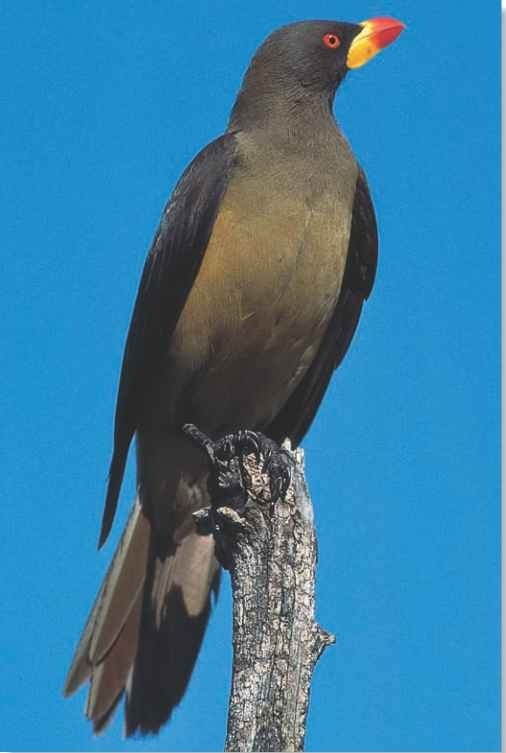
KEY FEATURES
• Make a living by feeding on the parasitic insects that infest big game and cattle
• Hitch a ride on their hosts, snapping up prey with a scissorlike bill
• Tolerated by their hosts because they perform a valuable service
• Nest cooperatively, with each breeding pair being supported by up to 3 to 4 individuals
WHERE IN THE WORLD?
Found from Sudan and Ethiopia in East Africa, across to the western coast of the continent, and south through Kenya, Uganda and Tanzania to South Africa
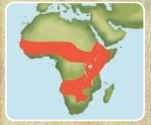
Lifecycle
Despite their name, oxpeckers do not limit their cleaning services to oxen. They can be found on many African mammals, nipping away at the parasites that infest their skins.
HABITAT
Oxpeckers are birds of the African savannah, where open, grassy plains are interspersed with light woodland and scattered shrubs. Their dependence on game animals means that they are common only in protected parks and reserves, where large herds live.
Because they nest in tree cavities, oxpeckers tend to be found in slightly wetter areas of savannah, where larger trees occur As well as obtaining food from their host, oxpeckers drink from the same waterhole and simply fly down from the animal to the water; and back again once they have quenched their thirst.
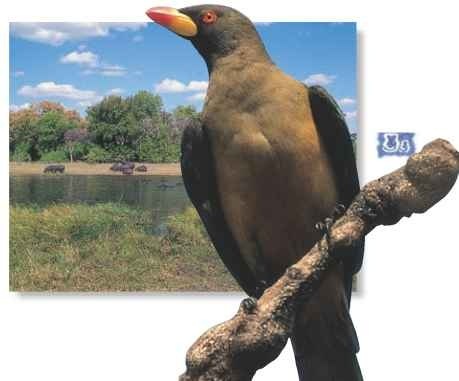
A Midday at the oasis The oxpecker frequents waterholes on savannah.
CONSERVATION
Where game herds are numerous, the oxpecker is not under threat. It is declining in areas where farmers remove ticks from livestock with chemicals.
FOOD & FEEDING
BREEDING
The oxpecker is a cooperative breeder. Each pair is assisted by up to four nonbreeding birds, which are usually offspring from previous broods. Breeding pairs mate on the ground or on the back of their mammal host. The pair normally places its nest high in a tree hole, but it may also nest under the eaves of buildings or in thatched roofs, rock cavities and embankments. The nest is an untidy, cup-shaped pad of grass and straw, lined with animal hair plucked from a host, and set on a foundation of dried dung.
The oxpecker usually lays 2-3 eggs, although clutches of one or even five have been recorded. The pair shares the incubating duties during the day, but only the female incubates at night. After two weeks the eggs hatch, and the chicks emerge thinly covered in down. Both parents care for the young, and helpers assist in feeding the brood. The chicks leave the nest after about four weeks, but are fed by their helpers and parents for three more months.
Family outing Dark juveniles may feed with adults.
The key to the oxpecker’s feeding technique is its ability to hitch a ride on the backs of large grazing mammals. The oxpecker visits a wide range of hosts, including the rhinoceros, buffalo, giraffe, zebra and hippopotamus, as well as large antelope species.
Ticks and other bloodsucking parasites make up nearly all of the oxpecker’s diet; ticks that are bloated with fresh blood provide the most nutrition. The oxpecker occasionally nibbles around the edges of old wounds, feeding on bits of loose skin, scar tissue and freshly flowing blood. It sometimes hunts on the wing, but is much less adept at this method of feeding.
Oxpeckers may act as sentinels, giving their host early warning of approaching predators.
Oxpeckers are also known as tickbirds.
Elephants, waterbuck and hartebeest do not tolerate oxpeckers.
Like other members of the starling family, oxpeckers have a range of calls, including shrill whistles and harsh chattering sounds.
The red-billed oxpecker is absent from the western parts of the genus’s range.
A MOVABLE FEAST
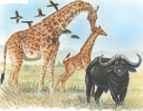
Time to eat…
A flock of hungry oxpeckers heads out over the savannah in search of mammals that are in need of its pest-removing services.
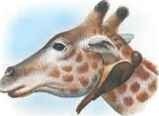
Mane course…
Clambering about a giraffe’s head, an oxpecker carefully probes the coat, looking for ticks and bloodsucking flies.

Necking…
Turning its bill sideways, flat against the animal, the oxpecker uses a scissorlike action to cut a tick free, before swallowing it whole.
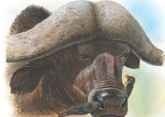
The perfect host
Ticks are found even on the nostrils, ears and eyelids. Buffalo tolerate the oxpecker in these rather sensitive areas.
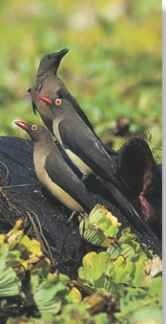
BEHAVIOR
During the day, the oxpecker travels in small groups, frequently uttering a sharp, hissing call as it flies about between the animals in a herd. At night, the oxpecker returns to a communal roost in a tree or a stand of reeds in a marsh. Sometimes a small party spends the night on its host’s back, perhaps to keep warm during cool weather
The distribution of the two species depends on their hosts. Both the red-billed and yellow-billed species favor less densely furred animals. Where they occur in the same area, the yellow-billed oxpecker seems to have first choice and is usually the species to be seen on sparsely haired mammals.
Backpacking Oxpeckers groom browsers such as kudu.
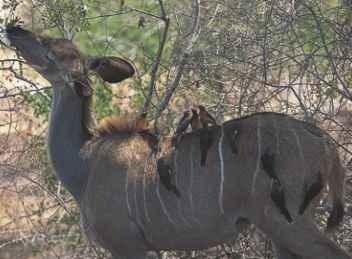
PROFILE
Oxpeckers
Sharing the powerful feet and stiff, proplike tail of woodpeckers, oxpeckers can keep a secure grip on animals as they walk along.
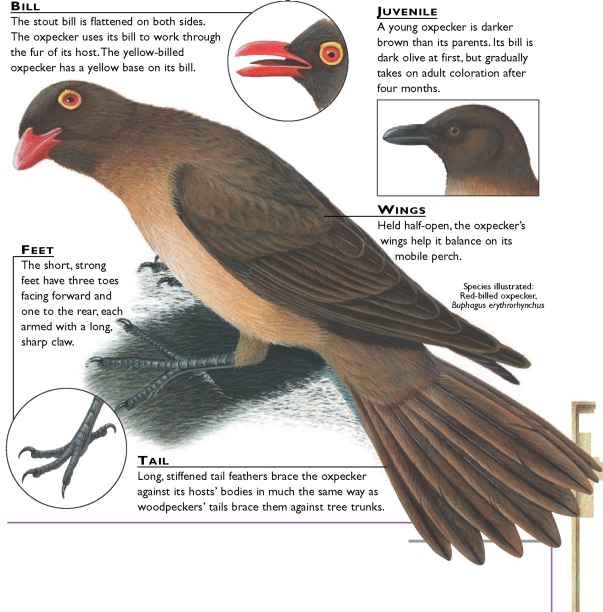
CREATURE COMPARISONS
The cattle egret (Bubulcus ibis), a member of the heron family, is not a relative of the oxpecker but shares its savannah nabitat.The two birds are often found alongside each other, associating ,.,:h large grazing animals. However the egret does not get its food directly off :he animals’ bodies. Instead, it walks alongside them snapping up * grasshoppers, locusts and beetles flushed from the vegetation as the heavy grazers wander over the grassland. Unlike the oxpecker, the egret is an uninvited guest and gives nothing back to the grazers in eturn for its meals. Standing about 20″ tall, the egret is much bigger than the oxpecker Long legs enable it to walk quickly near feeding herds, and large feet offer stability.


| VITAL STATISTICS | |
| Weight | 1.75 oz. |
| Length | 8-9″ |
| WlNGSPAN | 12″ |
| Sexual Maturity | 1 year |
| Breeding – Season | Wet season: September-February |
| Number of Eggs | 1-5, usually 2 or 3 |
| Incubation : Period | 12-14 days |
| Fledging Period | 26-30 days |
| Typical Diet | Mainly ticks, bloodsucking flies and lice; some loose skin and blood from open wounds |
| Lifespan | Unknown |
RELATED SPECIES
• There are 2 species of oxpecker in the genus Buphagus: thered-billed oxpecker, erythrorhynchus, and the yellow-billed oxpecker, B. africanus. They are confined to sub-Saharan Africa, but the red-billed species is less common. Oxpeckers belong to the family Sturnidae, which contains about 105 other species, including the introduced ‘ European starling.

